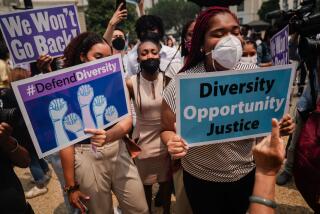Leading Has Many Shades of Gray
- Share via
Is leadership the same for everybody, or does race affect how leaders perform and are viewed?
Consider the dynamics of this team meeting:
Members of the group are discussing whether to build a brand-new copier or modify the one they have. An African American man makes a case for the former. He offers a persuasive argument, his voice and emotions forceful.
The team leader, who is white, responds: “Why are you upset?” Focusing on the emotions of the African American participant, the white manager misses the points he is making, thinking that if he’s emotional he can’t be rational. But in the mind of the African American, he is not angry. His tone and emotive speech are his way of showing he is passionate about the topic at hand.
This exchange, which appears in a videotape used by David Porter of UCLA, was presented recently to about 60 African American executives as part of an exercise.
“It resonated so clearly,” said Porter, an expert on race and gender issues in business and management at UCLA’s Anderson School. Porter said it was apparent how common this experience was among African Americans: “People think I’m angry when I’m very cool, calm and collected.”
It is but one illustration of how race can play a critical role in the success and failure of teams, and the leaders and participants in them. Yet, as Porter and others in corporate America note, leadership and training on the subject generally are not seen in a multicultural context.
“Most diversity training is a separate, stand-alone program that doesn’t focus on leadership,” said David Barclay, former vice president of work force diversity at Hughes Electronics in Los Angeles. And the reverse is also the case: Leadership training is usually done in a one-shot-fits-all approach.
“The basic characteristics of leadership remain the same,” said Barclay, who retired last fall after 27 years at Hughes. “But if you’re talking about the ability to influence and inspire people to support your vision and objectives, as the work force becomes more diverse, a good leader is going to have to recognize that different people have different styles of getting things done.”
That was a guiding belief behind the efforts of Porter, professor William Ouchi and others who helped establish the African American Leadership Institute at UCLA, the first of its kind at a major university’s executive education program. The institute had its first class earlier this spring--60 executives from around the country who spent three intensive days and nights discussing and probing issues of leadership and race.
The UCLA program was modeled on that of Leadership Education for Asian Pacifics, or LEAP, a 15-year-old nonprofit group in Los Angeles. UCLA is planning to develop a similar training center for Latinos.
“It addresses a void in the marketplace as far as executive management is concerned,” said Nike Irvin, director of the African American Leadership Institute.
As Irvin and others see it, the key issues on leadership and race revolve around behavior, values and perceptions. At LEAP and the African American Leadership Institute, instructors try to help people understand how culture affects their behavior and how that is seen by others, who often are working with stereotypes, such as that Asian Americans are quiet and passive.
J.D. Hokoyama, who heads LEAP, said it is important for minorities to understand the operating value system of corporate America--that is, white male--and how they can adjust or modify their behavior to enhance their career path. At the same time, Hokoyama said: “I don’t believe you have to change who you are or give up your ethnicity or values.”
Porter agrees. In the videotape exercise, for example, the African American could have chosen to tone down his emotion in presenting his case. But Porter said he could also have made it clear to the team that his emotions reflect his energy and passion for the issue, so he is not misunderstood.
Porter believes that the biggest issue for African American executives on the subject is that they do not get the same kind of recognition and rewards as whites do for their performance. He thinks that is often because white managers have selective memories framed by stereotypes.
“If you hold a stereotype that someone isn’t a good manager, then you won’t remember [a well-performed task] or you might say it was a fluke.”
Wilbur McKesson, 44, a senior vice president at Home Savings of America, said: “There is a need to prove oneself above and beyond to be accepted within senior ranks. There is a feeling you can’t make too many mistakes, any mistakes, whereas whites can.”
McKesson was a participant in the recent UCLA African American leadership class. The fee for the three-day training was $3,100, which participants’ companies picked up. McKesson, who has been with Home Savings for 11 years, said he had attended numerous leadership and training programs but that none previously had been dedicated solely to African American issues.
“One of the things African Americans don’t have as they move up is someone who they can speak to frequently about all sorts of issues, because there aren’t that many African Americans in senior levels,” he said.
Gene Boykins, 50, vice president of strategic staffing at Nestle in Glendale, thinks multicultural leadership is becoming even more important because of the emphasis on teams. Boykins said he is constantly working with teams that are being created and disbanded for specific tasks. Boykins, who is African American, said that when he forms a team, he looks for diversity.
That, he said, might initially create more challenges because a homogenous group is easier to work with. But in the long run, he said, “when you have a diverse group, they have a different paradigm for the way they look at problems. You’re more likely to get unique approaches and output.”
Boykins said he has come to learn about other cultures and how those differences can affect the way team members react to authority and the way they contribute in meetings. His strategy: diplomacy and strong emphasis on the common goal at hand.
“First, a leader has to be sensitive to those cultural differences,” said Boykins, who also attended UCLA’s program. “If you recognize it’s occurring, then you as a leader have to find a way to get the most out of the job.”
“As an African American, my antenna has to be up,” he added. “I need that person to get the job done. I have to find a way to get past any biases, to achieve the common goal.”



